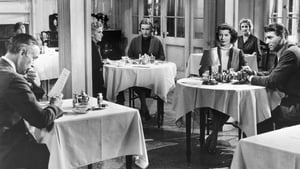Contact: [email protected]
Video Sources 0 Views
- Watch trailer
- Separate Tables Colorized


Synopsis
[ez-toc]




Introduction
In the ever-evolving landscape of cinema, where the echoes of the past harmonize with the innovations of the present, “Separate Tables Colorized 1958” stands as a testament to the enduring charm of classic films. The significance of colorization in breathing new life into old movies cannot be overstated, and this article delves into the intricacies of this transformative process, exploring its impact on “Separate Tables Colorized” and the cinematic realm as a whole.
Read Media File Transfer Agreement: Terms and Conditions
Read FAQ
Brief Overview of “Separate Tables Colorized” Film
“Separate Tables Colorized,” originally released in 1958, unfolds as a masterpiece crafted by the talented hands of director Delbert Mann, based on the play by Terence Rattigan. Set in a quaint British seaside hotel, the film weaves together the stories of its eclectic inhabitants, exploring the intricacies of human relationships and societal expectations. Now, with the magic of colorization, audiences have the opportunity to witness this classic in a vibrant new light.
Significance of Colorization in Preserving and Revitalizing Old Movies
Colorization, often a subject of debate among cinephiles, plays a pivotal role in preserving and revitalizing old movies. While purists may argue for the sanctity of black-and-white originals, colorization offers a fresh perspective that can make classic films more accessible to new generations. The process involves meticulous restoration techniques, carefully applied to enhance the visual and emotional impact of these cinematic gems.
What to Expect in the Article
In the following sections, we will delve into the artistry behind colorization, examining its impact on “Separate Tables Colorized (1958).” From the behind-the-scenes journey of crafting this cinematic masterpiece to the unique narrative it unfolds, we’ll explore the reception, awards, and legacy of the film. Additionally, we’ll guide readers on where to watch colorized classics and reflect on the importance of embracing both black-and-white and colorized versions of these cinematic treasures.
Understanding Colorization: Bringing Black and White Films to Life
Explanation of Colorization Process for Black and White Films
Colorization is a meticulous process that involves adding color to black-and-white films. This technique requires a delicate balance to retain the authenticity of the original while infusing it with vibrant hues. The goal is not to replace the black-and-white version but to offer a new viewing experience that resonates with contemporary audiences.
Challenges Faced in the Colorization Process and How They Are Overcome
Colorizing old films presents unique challenges, from accurately recreating historical settings to ensuring the colors align with the director’s original vision. Technological advancements have allowed for greater precision, with skilled artisans meticulously hand-painting frames or utilizing digital techniques to achieve the desired effect.
The Debate Around the Ethics of Colorizing Old Movies
The ethical debate surrounding colorization revolves around respecting the artistic intent of the filmmakers. While some argue that colorization can alter the intended atmosphere of a film, others contend that it breathes new life into classics, making them more appealing to contemporary audiences. Striking a balance between preserving the original and embracing innovation is key.
Examining the Impact: Colorization in “Separate Tables Colorized” (1958)
How Colorization Enhances Storytelling and Atmosphere
“Separate Tables Colorized” is a visual feast, and colorization amplifies its storytelling prowess. The vibrant hues breathe life into the characters and settings, adding a layer of depth to the emotional nuances of the narrative. The gentle sea breeze, the warmth of the hotel interiors, and the subtle expressions on the characters’ faces come alive in a kaleidoscope of colors.
Highlighting the Unique Visual Experience and Emotional Impact
Watching the colorized version of “Separate Tables (1958)” is akin to rediscovering a familiar masterpiece with fresh eyes. The visual experience is heightened, and the emotional impact resonates more profoundly. Colorization allows audiences to connect with the characters and their surroundings on a more intimate level, evoking a renewed appreciation for the film’s artistry.
The Making of a Masterpiece: Behind the Scenes of “Separate Tables Colorized”
Overview of “Separate Tables Colorized” (1958) Film
Before delving into the impact of colorization, let’s first revisit the brilliance of “Separate Tables Colorized.” Terence Rattigan’s play serves as the foundation, expertly adapted for the screen by a talented team of screenwriters. Delbert Mann, known for his sensitive and nuanced direction, brings the characters to life against the backdrop of a seaside hotel in Bournemouth.
Summary of the Plot and Setting
The film unfolds within the walls of the Beauregard Hotel, a haven for a disparate group of individuals whose lives intersect in unexpected ways. Each character harbors secrets and desires, creating an intricate web of relationships that the film delicately unravels. The setting itself becomes a character, its quaint charm contrasting with the complex emotions that unfold within.
Introduction to Each Main Character in the Film
“Separate Tables Colorized” boasts a stellar cast, with each actor contributing to the film’s magnetic allure. Rita Hayworth, Deborah Kerr, David Niven, and Wendy Hiller deliver performances that resonate long after the credits roll. The characters they inhabit are intricately woven into the fabric of the narrative, each carrying their own burdens and aspirations.
Mention of the Director and Screenwriters
Delbert Mann’s direction infuses the film with a poignant authenticity, capturing the subtleties of human interaction. The screenplay, a collaborative effort, navigates the complexities of Rattigan’s play, ensuring that the dialogue and pacing resonate with cinematic brilliance.
Discussion of the Performances by the Talented Cast Members
The performances in “Separate Tables Colorized” are nothing short of extraordinary. Rita Hayworth exudes a quiet elegance as Ann Shankland, while Deborah Kerr embodies the vulnerability of Sibyl Railton-Bell. David Niven, in an Oscar-winning role, portrays the enigmatic Major Pollock with nuance and depth. Wendy Hiller’s portrayal of the steadfast hotel manager, Miss Pat Cooper, adds a layer of gravitas to the ensemble cast.
Exploring the Narrative: A Comprehensive Plot Summary
Comprehensive Summary of the Plot
“Separate Tables Colorized” intricately weaves together the lives of its characters, each wrestling with their own demons. Major Pollock’s dark secret, Ann Shankland’s tumultuous relationships, and the delicate dance between guests and staff create a tapestry of human emotions. The film’s climax reveals the impact of societal judgments, challenging preconceived notions and laying bare the vulnerabilities that connect us all.
Reception, Awards, and Legacy
Discussion of Critical Reception and Audience Response
Upon its initial release, “Separate Tables Colorized” garnered critical acclaim for its stellar performances, sensitive direction, and nuanced exploration of human relationships. Audiences were captivated by the film’s ability to delve into complex emotional landscapes, making it a memorable entry in the cinematic canon.
Mention of the Film’s Oscar Nominations and Wins
The film received multiple Academy Award nominations, with David Niven securing the Oscar for Best Actor in a Leading Role. The nominations, including Best Picture and Best Actress for Deborah Kerr, highlight the film’s impact on both audiences and industry professionals alike.
The Enduring Legacy of “Separate Tables Colorized” (1958)
“Separate Tables Colorized” has left an indelible mark on cinema, standing as a testament to the power of storytelling and the exploration of the human condition. Its legacy extends beyond awards and critical acclaim, influencing subsequent generations of filmmakers and serving as a touchstone for those who appreciate the art of nuanced storytelling.
Bringing “Separate Tables” Home: The Journey to Home Media Release
Information About the Film’s Release on DVD and Blu-ray
For those eager to bring “Separate Tables” into their homes, the film is available on various home media platforms, including DVD and Blu-ray. The visual splendor and emotional resonance are preserved in these high-quality releases, allowing audiences to savor the film’s brilliance in the comfort of their own living rooms.
Availability and Special Features Included in the Home Media Versions
The home media releases of “Separate Tables” often come with special features that provide a deeper understanding of the film’s creation. Behind-the-scenes documentaries, interviews with cast and crew, and commentary tracks enrich the viewing experience, offering insights into the meticulous craftsmanship that went into making this cinematic gem.
Where to Watch Colorized Classics
Recommendations for Streaming Platforms or Websites
For those eager to explore colorized classics, streaming platforms and dedicated websites offer a treasure trove of cinematic experiences. From timeless black-and-white originals to their vibrant colorized counterparts, these platforms cater to diverse tastes, ensuring that classic film enthusiasts can embark on a journey through cinema history.
Preserving the Past: The Importance of Embracing Both Black and White and Colorized Films
Why It Is Crucial to Value and Protect Original Black and White Prints
While colorization opens new avenues for experiencing classic films, it is essential to recognize the intrinsic value of original black-and-white prints. These prints serve as historical artifacts, offering a glimpse into the cinematic techniques and artistic choices of a bygone era. Preserving these originals ensures that future generations can appreciate the unfiltered vision of filmmakers.
Acknowledging the Artistic Merits of Colorized Renditions
Simultaneously, embracing colorized versions expands the accessibility of classic films, introducing them to audiences who might be less inclined to engage with black-and-white cinema. The artistry behind colorization, when done with respect for the original, adds a layer of visual richness that can enhance the viewing experience without diminishing the value of the original.
Embracing the Beauty of Film in All Its Shades
Final Thoughts on Colorization, Old Films, Cinematic Artistry
In concluding our exploration of “Separate Tables Colorized 1958,” it becomes evident that the beauty of film transcends the limitations of color or lack thereof. Whether in the subtle monochromatic tones of black and white or the vibrant palette of colorized classics, each version offers a unique lens through which to appreciate the artistry of cinema. As audiences, let us embrace the beauty of film in all its shades, celebrating the timeless narratives that continue to captivate hearts across generations.
Encouraging readers to explore both black-and-white and colorized classics, this article seeks to foster an appreciation for the rich tapestry of cinematic history. “Separate Tables Colorized 1958” serves as a bridge between eras, inviting viewers to witness the convergence of past and present, ensuring that the beauty of cinema endures in all its shades.












